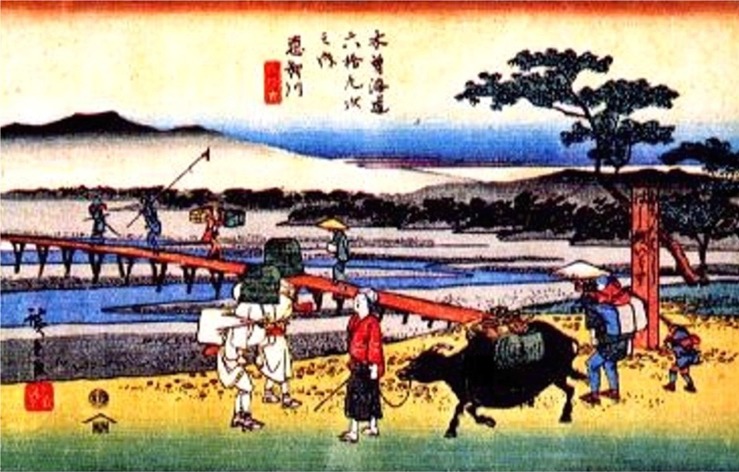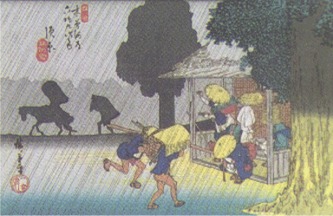

SHAKUHACHI
@
The Japanese bamboo flute
| Go to 1.8 Shakuhachi - Go to 2.3 Shakuhachi - Go to Frequently Ask Questions |

@
Itfs in the 6th century that we can find manuscripts of the bamboo flutes showing its use. In the 7th century, the bamboo flute belonged to the instruments used during the representations given at the court, music known under the name of Gagaku.
Shôsôin, the House of the
treasures of the Tôdaiji temple (known for its great Buddha)
preserved 8 of these flutes. On the 8 flutes, only 5 are in bamboo. The 3
others are made of jade, ivory and stone. These 3 flutes were carved in
order to represent the nodes of the bamboo.
A 9th Gagaku Shakuhachi is also preserved at the national museum of Tokyo, and would have belonged to the emperor Shôtoku Taishi (574-622). Shôtoku Taishi was recognized for his knowledge and love of music.
It
is in the 13th century that Shakuhachi of the Fuke sect was introduced by
the Grand Master Hottô. Shakuhachi was then considered not as a musical
instrument but as a religious instrument.
This
Buddhist sect opened at its origin to people wishing to enter the sect,
accepted later only the members born from the noble class of the warriors,
the Samurai.
These warrior monks called Komuso
(³m monks of Emptiness), were itinerant monks.
|
During Edo era (1603-1868), Komusô pilgrim monks played an
important role in the maintenance of law and order established by
the Shogun government of Tokugawa aiming to maintain a durable peace
and to thwart political intrigues. This internal political stability
made it possible to preserve a lasting peace during 265 years. In the 18th century, a new style of music was born through
the Kinko-ryû school. Kinko Kurosawa, his creator, arranged
traditional pieces of which he had received teaching to make more
furnished and heavier pieces. This style derived from the Fuke sect
left many writings on its development. |
|
At
the end of Edo government, number of people not belonging to the class of
the warriors put on the clothes of Komusô for various reasons. These
impostors played popular pieces not belonging to the traditional repertory
of the Fuke sect.
With
Meiji restoration (1868), in 1871, Fuke sect was banned by the new regime
in place because of its implication and its active role in the government
of Tokugawa.
Thereafter, recitals in public with three instruments (Sankyoku:
Shakuhachi, Koto, and Shamisen) were privileged to the practice in solo.
It is as from this time that Shakuhachi was democratized in the
middle-class of the society via the recitals given in public.
The tradition and the teaching from
Master to disciple of the Fuke sect despite continued to be transmitted
through some grand Masters like Miyakawa Nyozan ({μ@R), Kobayashi Shizan (¬ΡR),
Okazaki Meido (ͺθΎΉ), Katsuura Shozan (Y³R), Takahashi Kûzan
(΄σR), and today
Fujiyoshi Etsuzan (‘RzR), but remain limited because of its
elitist and secret character.
These genius instrumentalists while preserving the heritage they
had received, opened new horizons to Shakuhachi to allow it to take a
new musical dimension.
With Meiji era (1868-1912), some members of the Fuke Shakuhachi sect around Kyôto decided to continue their practice openly and the friendly association of the Myôan Temple was created in 1883 (name drawing its origins from the Myôan temple of the Fuke sect located at Kyôto). The teaching pieces are mainly those which were transmitted to the Myôan temple. This association, more known nowadays under the name of school Myôan-ryû (ΎΓ¬ also named vulgarly Meian-ryû) is often studied by the members of the schools Kinko and Tozan who seek to approach the original parts which are not taught any more in their style.
|
|
The school Tozan-ryû, another style appeared at the end of the 19th century. Its creator Tozan Nakao born in the area of Kansai where the style developed and continues to thrive. Tozan created and developed specific parts to his style. These solos and ensemble represent the tradition of this school. This school is currently the most important in number of practicing people. All these schools and various styles contributed to enrich and develop the repertory of the bamboo flute. These same schools gave rise to many other modern schools. |
| If one could attend the drift of some styles - where the noise is privileged to the music and where some passages having to be played with smoothness are played with force and heaviness and sometimes the opposite - and the appearance of a certain form of musical decline, one can estimate that they reflect their time and made Shakuhachi possible to evolve more or less well with its time. Moreover for a few years one has attended, a return to more reliable values. |
| Return to Japanese Art Objects - Go to Description - Email to Shibui Swords |

